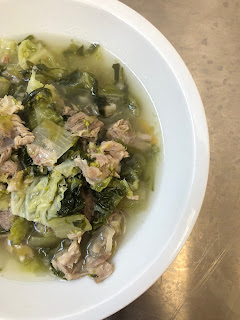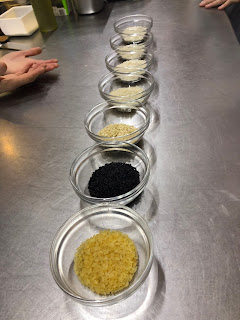Cooking Campanian Cuisine
The wonderful and delicious region of Campania! This is a region located in southern Italy and is the third most populated region of Italy, but based on land mass, it is the most densely populated region of all of Italy. Campania was an important piece of the Magna Grecia, or Greek civilization. The land of Campania has a very rich culture, with deep traditions, especially when it comes to food. Pompeii, Herculaneum, Paestum, and Velia are all ancient archeological sites within the region as well. The name Campania comes from a Latin derivative, Campania felix, meaning "fertile countryside."
I felt like today I did not learn very much about the history of Campania, so I decided to look more into it. Here is what I found:
The original group of people who inhabited Campania was made up of three different groups: the Osci, the Aurunci, and the Ausones. Although they were three different groups, they shared a common language. Around the 8th century BC, the Greeks came and established colonies in the area around what is now Naples. This population was referred to as the Euboea people. A population also came from central Italy as well, the Samnites. This population was very warlike, therefore they took over the cities of Capua and Cumae. This was very fertile and important land at the time and the Campanian people had a difficult time without it. During 340 BC, the Samnites began a war with the Romans, knowns as the Samnite Wars. The Romans took the rich pastures in northern Campania.
Very little was left, but what remained was the independent Greek settlement known as Neapolis. Unfortunately, the Samnites also took this settlement and the Neapolitans were left with nothing. They decided to take the Romans on their side and built an alliance with them. This set off the Second Samnite War, which recaptured Neapolis and allowed the Greek city to thrive once again.
Due to the rich history and traditions, it is no surprise that this region has a lot of DOP and Slow Food products. Here, I have listed some:
- Pomodorino del Piennolo del Vesuvio DOP: This product is a tomato grown in the fertile volcanic soil from Mount Vesuvio. The soil is very rich and creates a very sweet and tasty tomato. The cultivation of this tomato is still done through traditional methods using a wooden stick and wires to gold the fruit off the ground. When the tomatoes are ready, they are harvested and hung to give them a chance to fully ripen.
- Provolone del Monaco DOP: This is a pulled paste cheese made with cow's milk. The name comes from an old story: The producers of this cheese would walk from the mountains to the coast to sell the cheese and they wore burlap sacks, looking like monks. The name provolone del Monaco means "provolone of monks."
- Cacioricotta Caprino del Cilento DOP: This cheese is produced with both regular cheese and ricotta. The milk is cooked to 90 C, then brought down to 40 C. It is made like ricotta, then rennet is added and the cheese is broken. This is a cheese made with 2 different methods, formed into one.
- Coniglio di Fosso Slow Food Procedure: This is a specific way of breeding rabbits. Farmers dig a deep hole and put the rabbits in it with a net on top. Once the rabbits begin digging tunnels, the place a trap to catch them.
- Oliva Salella Ammaccata del Ciento Slow Food Procedure: This is an olive that is picked before it is totally ripe and then is crushed. They are then put in water which must be changed for 20 days. This makes them very rich and sweet, removing the saltiness and bitterness from the olives.
Fun Fact of the Day
In Campania, they have 2 products labeled Specialita Tradizionale Garantita (STG). These are both the cheese and pizza that is made in the region:
Mozzarella
Pizza Napoletana
Today, I made 3 different recipes, 2 with Logan and one with another group member. Here is what they were and how I felt about them:
1. Minestra Maritata (meat and winter vegetable soup): This soup was made with really any meat that we had from pork to sausage and beef rounds. The meat goes into a pot of water with onions, celery, and carrots for about 2 hours. After that, the meat is cut and the vegetables are added: chicory, broccoli rabe, escarole, and savoy cabbage. Then, it is cooked just to make all of the flavors come together.
I really enjoyed this soup as it was simple to make but delicious to eat. I would maybe even add rice to this, as it would add another texture and element to the dish. The veggies were not bitter as they were boiled for a little while.
2. Impepata di Cozze: This was a very simple mussel dish where the mussels were steamed in garlic and oil. They were then seasoned with a lot of black pepper and parsley. It was served with a garlic crostini.
Again, this preparation was very simple but tasty. I would maybe serve these mussels over something or with a little sauce as I thought they were a little too simple, but it really allowed the mussels to shine.
3. Pizza fritta napoletana: This was a fried pizza! It is made with flour, salt, water, and yeast, then allowed to proof for a while. Then you shape the balls, allow more proofing, and then they are rolled out. The dough is then fried and topped with whatever your heart desires.
This was excellent! It is something I would make at home for dinner, but not really in a restaurant. It was something different that I enjoyed helping to create.
With love,
Baylee
I felt like today I did not learn very much about the history of Campania, so I decided to look more into it. Here is what I found:
The original group of people who inhabited Campania was made up of three different groups: the Osci, the Aurunci, and the Ausones. Although they were three different groups, they shared a common language. Around the 8th century BC, the Greeks came and established colonies in the area around what is now Naples. This population was referred to as the Euboea people. A population also came from central Italy as well, the Samnites. This population was very warlike, therefore they took over the cities of Capua and Cumae. This was very fertile and important land at the time and the Campanian people had a difficult time without it. During 340 BC, the Samnites began a war with the Romans, knowns as the Samnite Wars. The Romans took the rich pastures in northern Campania.
Very little was left, but what remained was the independent Greek settlement known as Neapolis. Unfortunately, the Samnites also took this settlement and the Neapolitans were left with nothing. They decided to take the Romans on their side and built an alliance with them. This set off the Second Samnite War, which recaptured Neapolis and allowed the Greek city to thrive once again.
Due to the rich history and traditions, it is no surprise that this region has a lot of DOP and Slow Food products. Here, I have listed some:
- Pomodorino del Piennolo del Vesuvio DOP: This product is a tomato grown in the fertile volcanic soil from Mount Vesuvio. The soil is very rich and creates a very sweet and tasty tomato. The cultivation of this tomato is still done through traditional methods using a wooden stick and wires to gold the fruit off the ground. When the tomatoes are ready, they are harvested and hung to give them a chance to fully ripen.
- Provolone del Monaco DOP: This is a pulled paste cheese made with cow's milk. The name comes from an old story: The producers of this cheese would walk from the mountains to the coast to sell the cheese and they wore burlap sacks, looking like monks. The name provolone del Monaco means "provolone of monks."
- Cacioricotta Caprino del Cilento DOP: This cheese is produced with both regular cheese and ricotta. The milk is cooked to 90 C, then brought down to 40 C. It is made like ricotta, then rennet is added and the cheese is broken. This is a cheese made with 2 different methods, formed into one.
- Coniglio di Fosso Slow Food Procedure: This is a specific way of breeding rabbits. Farmers dig a deep hole and put the rabbits in it with a net on top. Once the rabbits begin digging tunnels, the place a trap to catch them.
- Oliva Salella Ammaccata del Ciento Slow Food Procedure: This is an olive that is picked before it is totally ripe and then is crushed. They are then put in water which must be changed for 20 days. This makes them very rich and sweet, removing the saltiness and bitterness from the olives.
Fun Fact of the Day
In Campania, they have 2 products labeled Specialita Tradizionale Garantita (STG). These are both the cheese and pizza that is made in the region:
Mozzarella
Pizza Napoletana
Today, I made 3 different recipes, 2 with Logan and one with another group member. Here is what they were and how I felt about them:
1. Minestra Maritata (meat and winter vegetable soup): This soup was made with really any meat that we had from pork to sausage and beef rounds. The meat goes into a pot of water with onions, celery, and carrots for about 2 hours. After that, the meat is cut and the vegetables are added: chicory, broccoli rabe, escarole, and savoy cabbage. Then, it is cooked just to make all of the flavors come together.
I really enjoyed this soup as it was simple to make but delicious to eat. I would maybe even add rice to this, as it would add another texture and element to the dish. The veggies were not bitter as they were boiled for a little while.
2. Impepata di Cozze: This was a very simple mussel dish where the mussels were steamed in garlic and oil. They were then seasoned with a lot of black pepper and parsley. It was served with a garlic crostini.
Again, this preparation was very simple but tasty. I would maybe serve these mussels over something or with a little sauce as I thought they were a little too simple, but it really allowed the mussels to shine.
3. Pizza fritta napoletana: This was a fried pizza! It is made with flour, salt, water, and yeast, then allowed to proof for a while. Then you shape the balls, allow more proofing, and then they are rolled out. The dough is then fried and topped with whatever your heart desires.
This was excellent! It is something I would make at home for dinner, but not really in a restaurant. It was something different that I enjoyed helping to create.
With love,
Baylee






Comments
Post a Comment